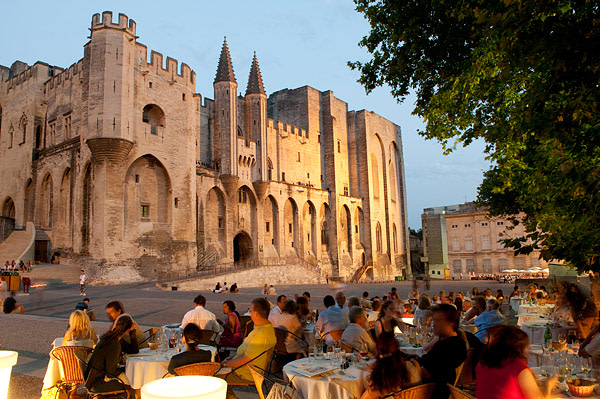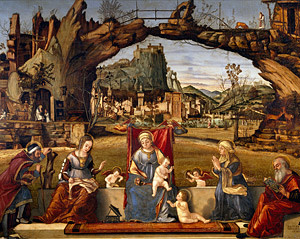Avignon: a city at ease with its rollercoaster past

Simply sign up to the Life & Arts myFT Digest -- delivered directly to your inbox.
“Men are we,” wrote Wordsworth about Venice, “and must grieve, when even the Shade/ Of that which once was great is passed away”.
Yes and no, in my opinion. I grieve, of course, for Venice, reduced from world power to tourist destination, but it seems to me some places positively rejoice in their lost importance, and one such is Avignon. It is a middle-sized provincial capital of France, with a population of 95,000. But for six decades in the 14th century it was the capital of the Christian world.
It was not born great but had greatness thrust upon it when, in 1309, the newly elected French Pope Clement V decided that he would rather not live in Rome and settled instead in this pleasant small town beside the Rhone. He brought with him the entire papal curia, with all its cardinals, priests, chaplains, scholars and administrators, and six of his successors followed him, creating on the riverbank a city of glorious consequence.
There is no grieving here, I can tell you. Especially if you arrive at Avignon’s gates on a warm evening and wander into the city centre through its nook-and-cranny alleys: you will soon enjoy a shot in the arm of sheer exhilaration. Suddenly you see before you, brazenly floodlit, the colossal palace, with attendant cathedral, that the popes of Avignon built for themselves all those centuries ago.

The ensemble looks new. It looks a bit stagy, actually. It is all museum and conference centre now, beautifully preserved and arrogant: a tremendous cluster of towers and ramparts and staircases, with a golden figure of the Virgin on the cathedral tower. One great structure leads to another, with passages and staircases and ceremonial gateways, and all is attended by a vast paved courtyard, with a peaceful garden of trees on rising ground behind. Do not expect any golden silence, though. It is a terrific spectacle but it is a performance, too, with a distinct suggestion of chaos. In the Place du Palais, at a few hundred café tables, a few thousand visitors are loudly talking, laughing, calling for coffee, taking pictures, tapping their feet to the rhythm of a combo of one sort or another that is playing somewhere out of sight.
…
Let us find a table ourselves – or, better still, walk a few hundred metres from that vortex of papalness to the main municipal square of the town. This is itself cluttered throughout with café tables but it is more aldermanic in manner, less exaggerated, with a sober city hall and a theatre. It is a more proper place to sit down and contemplate the nature of this remarkable city.
Avignon’s pre-papal career was a sort of historical bouillabaisse, involving Romans, Goths, Saracens, the Holy Roman Empire, the Albigensian Crusade, Charles Martel, Louis the Stammerer, sundry counts of Provence and a queen of Sicily. Even after the glorious interlude of the seven popes, a desperate doctrinal schism in Rome induced a couple of antipopes to set up their own thrones here, and after a further melange of sovereignties it was only in 1791 that Avignon became definitively French.

Perhaps it is this rollercoaster past that has given the city its effervescence. It has escaped the worst of modern wars and has skilfully exploited its inherited complexities. The Avignon that the world knows – the small walled city beside the Rhone – has, in fact, long been invested by sprawling and more ordinary extramural developments, but you would not know it. Sitting here in the Place de l’Horloge, where the town hall clock mellowly strikes the hours as we toy with our ice creams, my overwhelming sensation is one of compact civic complacency. Snug within its ancient (but heavily reconstructed) ramparts, old Avignon feels to me wonderfully self-contained, neat, complete and pleased with itself.
Of course, a benign climate, lovely country surroundings, great cuisine and intriguing architecture make for happy temperaments, and it is not surprising that the motif of Avignon’s very own theme song, “Sur le Pont d’Avignon”, is an invitation to go dancing under the remaining arches of the city’s bridge over the Rhone.
…
Oh yes, one can have many kinds of good time in Avignon. In the train of the Popes every sort of entrepreneur came to make money here, mighty Jewish financiers from Munich and Venice, artists and entertainers of many persuasions who have bequeathed their lively influences, to this day. The annual Avignon Festival, which more or less takes over the city during June, is one of the great civic festivities of all Europe. But for my money simply being in Avignon is festival enough.

You want food? Here are three local dishes that may not be to your taste but certainly pleased mine. The first was a pot of frozen yoghurt with lychees in it, messily eaten on a park bench in the shade of the Eglise Saint-Martial. The second was scrumptiously expensive coquilles St Jacques, accompanied by Bach fugues from a virtuoso street accordionist. And the third was a half-dozen oysters on the shell, washed down by dry white wine at a corner stall of the covered market.
You want people? Merciful heavens, there’s no better place for people-watching, with the city centre an anthropologist’s delight. For wild variety of costume, for ethnic complexity, for cheerful exhibitionism, for the uninhibited antics of children and soigné continental assurance, there is nowhere better than Avignon. I could have spent half the day watching the goings-on at the carousel outside the old Opera House, where human conduct from infancy to senility is entertainingly enacted.
The streets of Avignon are so narrow and convoluted that walking is the best way to get around but this provides another of the city’s compensations. In the days of the popes, all the cardinals, too, had their lesser palaces and churches, so there is hardly a corner of old Avignon that is not architecturally interesting, and the skyline is as pierced by ancient towers as Damascus’s is by minarets.
…
And so we realise, as we potter, stare, guzzle, laugh and respond to the charm of the French, that the real attraction of the place, its grandest bequest from the Popes, is its profound sense of historical beauty.
Sometimes, through one of the city gates, you may see gliding up the river one of the immense white Rhone pleasure-craft that sail between Lyon to the north and Marseille to the south. Their graceful passages remind me that there is a geographical beauty to Avignon too. For centuries, vessels have sailed that great river from Switzerland to the Mediterranean, and here across the successive bridges of Avignon trade and traffic, ideas and influences, have passed from one side of southern Europe to the other. It is an elegant demonstration of Avignon’s original raison d’être, the first source of its culture.

And not just culture, but an instinct for culture – something that was fostered at this significant site by the presence of those medieval popes, in their palace above the stream. There are scores of museums and art galleries in Avignon, besides many ancient churches, and they are full of the genius of all the ages. So wherever you are eating your breakfast croissant or buying your sunglasses, you are never more than an easy stroll from some prodigious masterpiece.
As it happens, I have come to Avignon specifically with one such masterpiece in mind. I want to see for myself a picture of the Holy Family painted in the early 16th century by the Venetian Vittore Carpaccio. I know it hangs in the museum of the Petit Palais, and I know it contains a small visual puzzle that no reproduction has ever solved for me.

Finding it turns out to be an excursion into the very soul of the city, for the museum stands at the head of the Place du Palais and is itself the beautiful former palace of a 14th-century cardinal. Up the great plaza I walk, while the anonymous music plays, past the cafés and the place where the sightseeing buses wait, through the grand façade of the museum, along a cold dark corridor, down a silent spiral staircase, until I find myself in a long stony chamber miraculously full of sacred paintings from the Italian Middle Ages, gold-framed and lustrous around me.
In the middle of the room, all on its own, is my Carpaccio. As a matter of fact I do not find in it the solution to my puzzle but I do not mind. To be there in that place is enough. And I feel sure Carpaccio would agree.
——————————————-
Details
Jan Morris was a guest of Kirker Holidays, which offers three nights’ bed and breakfast at the Hotel de L’Horloge from £648 per person based on two sharing, including return on Eurostar from London to Lille and car transfers
Comments